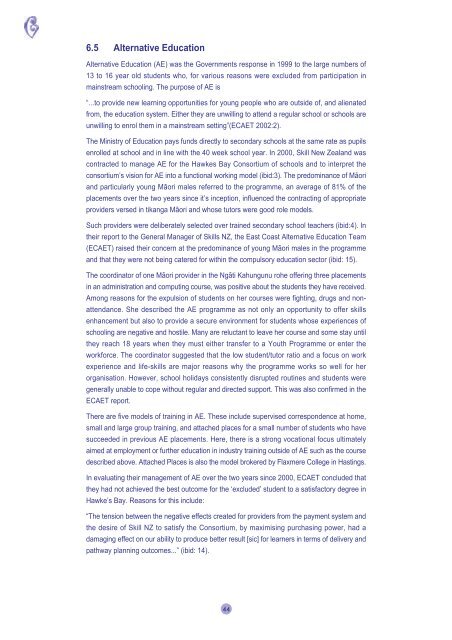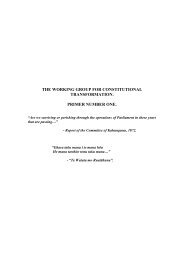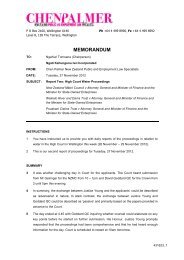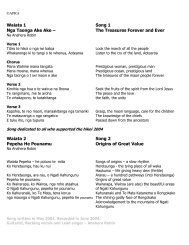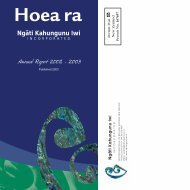Matauranga Strategy - NgÄti Kahungunu Iwi Incorporated
Matauranga Strategy - NgÄti Kahungunu Iwi Incorporated
Matauranga Strategy - NgÄti Kahungunu Iwi Incorporated
Create successful ePaper yourself
Turn your PDF publications into a flip-book with our unique Google optimized e-Paper software.
6.5 Alternative Education<br />
Alternative Education (AE) was the Governments response in 1999 to the large numbers of<br />
13 to 16 year old students who, for various reasons were excluded from participation in<br />
mainstream schooling. The purpose of AE is<br />
“...to provide new learning opportunities for young people who are outside of, and alienated<br />
from, the education system. Either they are unwilling to attend a regular school or schools are<br />
unwilling to enrol them in a mainstream setting”(ECAET 2002:2).<br />
The Ministry of Education pays funds directly to secondary schools at the same rate as pupils<br />
enrolled at school and in line with the 40 week school year. In 2000, Skill New Zealand was<br />
contracted to manage AE for the Hawkes Bay Consortium of schools and to interpret the<br />
consortium’s vision for AE into a functional working model (ibid:3). The predominance of Mäori<br />
and particularly young Mäori males referred to the programme, an average of 81% of the<br />
placements over the two years since it’s inception, influenced the contracting of appropriate<br />
providers versed in tikanga Mäori and whose tutors were good role models.<br />
Such providers were deliberately selected over trained secondary school teachers (ibid:4). In<br />
their report to the General Manager of Skills NZ, the East Coast Alternative Education Team<br />
(ECAET) raised their concern at the predominance of young Mäori males in the programme<br />
and that they were not being catered for within the compulsory education sector (ibid: 15).<br />
The coordinator of one Mäori provider in the Ngäti <strong>Kahungunu</strong> rohe offering three placements<br />
in an administration and computing course, was positive about the students they have received.<br />
Among reasons for the expulsion of students on her courses were fighting, drugs and nonattendance.<br />
She described the AE programme as not only an opportunity to offer skills<br />
enhancement but also to provide a secure environment for students whose experiences of<br />
schooling are negative and hostile. Many are reluctant to leave her course and some stay until<br />
they reach 18 years when they must either transfer to a Youth Programme or enter the<br />
workforce. The coordinator suggested that the low student/tutor ratio and a focus on work<br />
experience and life-skills are major reasons why the programme works so well for her<br />
organisation. However, school holidays consistently disrupted routines and students were<br />
generally unable to cope without regular and directed support. This was also confirmed in the<br />
ECAET report.<br />
There are five models of training in AE. These include supervised correspondence at home,<br />
small and large group training, and attached places for a small number of students who have<br />
succeeded in previous AE placements. Here, there is a strong vocational focus ultimately<br />
aimed at employment or further education in industry training outside of AE such as the course<br />
described above. Attached Places is also the model brokered by Flaxmere College in Hastings.<br />
In evaluating their management of AE over the two years since 2000, ECAET concluded that<br />
they had not achieved the best outcome for the ‘excluded’ student to a satisfactory degree in<br />
Hawke’s Bay. Reasons for this include:<br />
“The tension between the negative effects created for providers from the payment system and<br />
the desire of Skill NZ to satisfy the Consortium, by maximising purchasing power, had a<br />
damaging effect on our ability to produce better result [sic] for learners in terms of delivery and<br />
pathway planning outcomes...” (ibid: 14).<br />
44


